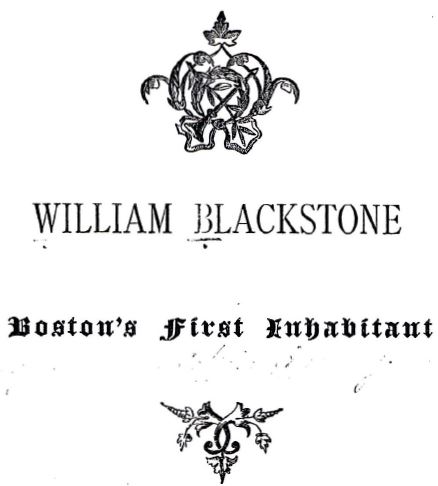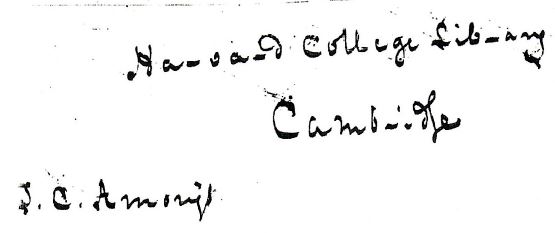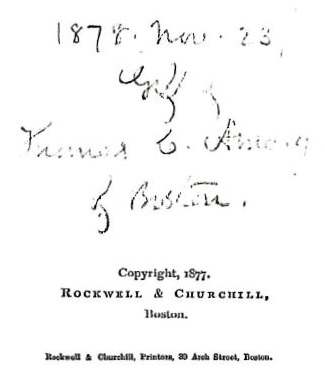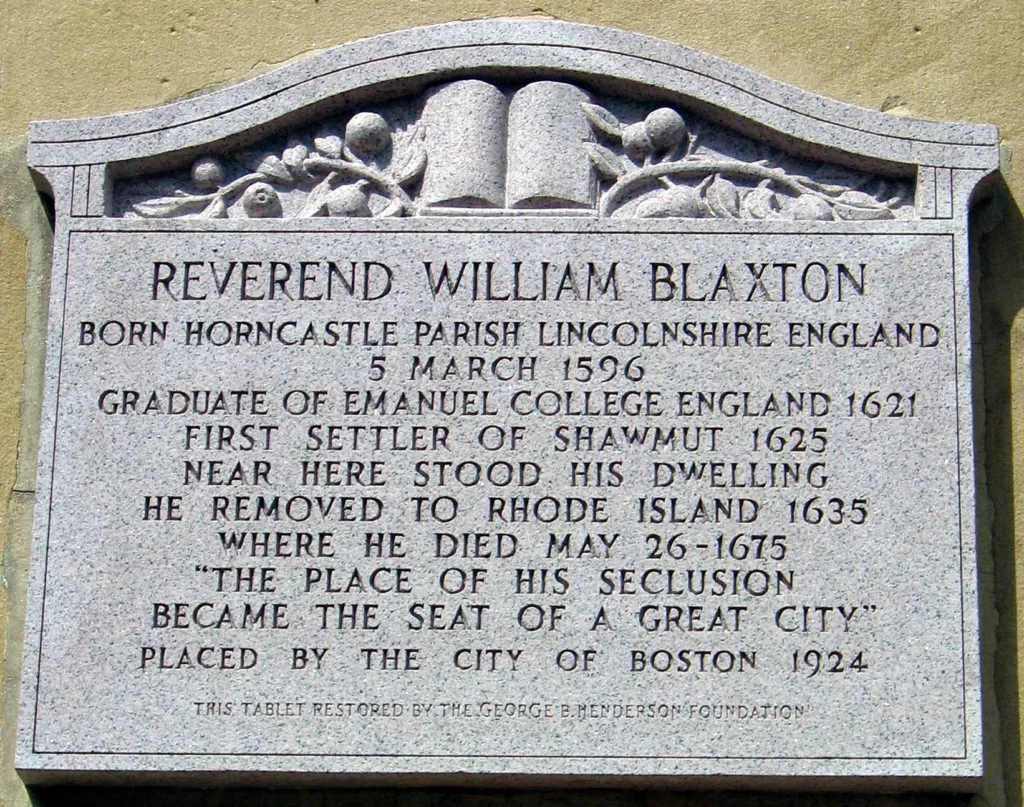



 or several years previous to the first settlement of Boston, in September, 1630, William Blackstone, its earliest European inhabitant, occupied by himself what formed for long afterwards the principal part of it, the peninsula known as Shawmut. This originally comprised an area of about eight hundred acres, since more than doubled by accessions from the sea, the whole with much besides annexed to our city from the country round about, now crowded with population. Blackstone, a man of learning, an ordained minister of the Church of England, and, consequently, a graduate of one of its universities, unwilling to conform to ecclesiastical requirements which his conscience disapproved, had come to America ” to get from under the power of the lords bishops.” Here he dwelt, solitary and alone, raising his apples and roses, and rending his books, of which he had a plentiful supply.
or several years previous to the first settlement of Boston, in September, 1630, William Blackstone, its earliest European inhabitant, occupied by himself what formed for long afterwards the principal part of it, the peninsula known as Shawmut. This originally comprised an area of about eight hundred acres, since more than doubled by accessions from the sea, the whole with much besides annexed to our city from the country round about, now crowded with population. Blackstone, a man of learning, an ordained minister of the Church of England, and, consequently, a graduate of one of its universities, unwilling to conform to ecclesiastical requirements which his conscience disapproved, had come to America ” to get from under the power of the lords bishops.” Here he dwelt, solitary and alone, raising his apples and roses, and rending his books, of which he had a plentiful supply.
His solitude was unpleasantly disturbed in the summer of 1630 by the arrival at Charlestown, across the river, of Winthrop and his company, under their patent of March 4, 1629. Their lives in peril from disease engendered by exposure and privation, and aggravated by the impurity of the water, he generously invited them over to share with him the more salubrious spot he inhabited, and which abounded in springs.
Cheerfully yielding up to them the greater part of his possessions, he was contented himself to retain fifty acres adjacent to the spot whereon stood his house. Our story intimates how it chanced that, a few years afterwards, “finding he had fallen under the power of the lords brethren,” he surrendered this lot and all his other rights within the then narrow neck of land connecting the peninsula with Roxbury, excepting six acres. He received six shillings from each householder, and, in some instances, larger sums in volunlary contributions, for this release. It has been said that he disclaimed any other title but that of first discoverer and occupant, but this release shows that the colonists considered his title to some extent, at least, valid or equitable. In 1623, the Council of New England had patented to Robert Gorges ten miles along the north-east shore of Massachusetts Bay, by thirty inland, with all islands, not previously granted, within three miles of the main land. Walford, at Charlestown; Maverick, on what is now East Boston; Thompson, who died in 1628, on the island that still bears his name; Blackstone, at Shawmut, are supposed to have held uncle,· this patent, and been pioneers of a projected plantation.
Sir Ferdinando Gorges had received large grants from the Council farther north. Interested in the speedy colonization of the country, he caused his son Robert to surrender his patent, and another issued, vesting in Winthrop and his associate what it covered, with the rest of Massachuselts, outside the limits of Plymouth, to the western sea. John Blackstone, a member of Parliament, appears to have taken an active interest in the affairs of the infant plantations. As one of a parliamentary committee, in 1642, he invited Cotton, Hooker, and Davenport to come over for consultation upon the general condition of the realm. As one of the Council, he joined in a power to William Blackstone to deliver seisin under one of its patents. No consanguinity is known between John and William; but their bearing the same name justifies the conjecture that such existed; that our first settler did actually possess claims entitled to compensation for their relinquishment; and that John’s position in the Council may have led William to take up his residence in New England, when constrained by conscience to abandon the Church.
Whereabouts, precisely, on the peninsula was his dwelling-place has long puzzled our historians. Some of the earlier authorities speak of his residing on Blackston’s Point, Cambridge Bay, opposite the mouth of Charles River. It seems not to have occurred to Shaw, Snow, Drake, and Shurtleff that his name might attach at that period to all Shawmut; and, regarding Barton’s Point as what was intended, they located his house variously on Poplar or Cambridge streets or a mile away in the vicinity of Charlestown Bridge. The publication of Odlin’s deposition, dated June 10, 1684, recorded with Suffolk Deeds, 26-84, as to Blackstone’s release, discouraged the hope that further information might be gleaned by examination of these ancient volumes. The correspondence in area of the lot reserved by Blackstone, or assigned to him in 1631, and that appropriated soon after his surrender as a common and training-field, and of his six acres to part of that conveyed by Copley to Harrison G. Otis and Jonathan Mason, in 1796, long since led the present writer to the conclusion that our beautiful Common was no other than his park and pasture; that his orchard lay close by, and was substantially the same laid down as Bannister’s gardens, on Burgiss’ map of 1728, and that his house stood on the ground bounded by Beacon,Walnut, and Spruce streets, near to which latter street the sea then ebbed and flowed.
Under the impression that his connection with our early history was too interesting an episode not to be kept in mind, the subject shaped itself into the present form; and whilst thus engaged, another effort was made to procure, if possible, such additional light as the Suffolk Registry afforded. No conveyance is there believed to be recorded of the six-acre lot from Blackstone, none to Copley, and the earliest is that of the Brncketts to Williams and Vial in 1676, from whom, in 1709, it passed to Thomas Bannister. From his heirs, by foreclosure of mortgages or other process of law, and deed not recorded, it eventually came to Copley before 1770. The deposition taken in 1711 of Mrs. Ann Pollard, the first of Winthrop’s company, as mentioned in the text, to leap ashore upon the peninsula, and who lived till 1725, when she had reached the age of 105, states that Blackstone sold on his homestead to Richard Pepys, who built a house on the land, of which her husband was the tenant, and possibly Pepys may have occupied another himself on the property. When Copley conveyed, in 1796, two then ancient houses stood upon his estate, in one of which he painted many of his admirable portraits, and there his distinguished son, Lord Chancellor Lyndhurst, was born.
The area then actually passing came nearer to twenty acres in all, the ordinance of 1647 giving proprietors of the upland one hundred rods below high-water mark.
Pepys may have gone home at the restoration of the monarchy, or earlier. We do not know that he was not the same Richard Pepys, cousin of Samuel, the entertaining diarist, and the Irish judge of 1664, from whom Lord Cottenham, chancellor in 1836-41, and a successor of Lyndhurst, descended. It would be agreeable to trace, in addition to these associations of great legal luminaries with the spot, yet another of the kind, and discover that our Blackstone was of the same family as his namesake, Sir William, the distinguished commentator on the Laws of England, whose volumes never grow old and arc ever pleasant to read, and who was born in London, son of Charles, in 1723, and died in 178o. The son of our William had sons, one of whom, a lieutenant, fell at the siege of Louisburg, in 1746. The only promising clue to the parentage and birthplace of our first inhabitant is a power, in 1653, of Sarah Blackstone (Suffolk Deeds) to collect money advanced, in which she is described as of Newcastle-upon-Tyne, and which mentions the name of Stevenson, that of the first husband of Blackstone’s wife.
In 1638 the authorities granted Blackstone fifteen acres at Muddy Brook, now Brookline, then a part of the town of Boston. He may have continued a freeman and possibly not have sold his estate, but it is generally presumed that he left with his cattle and books for Rehoboth in the spring of 1635. In a house he called Study Hall, a few rods from the river now bearing his name, on the declivity of what he called Study Hill, about sixty feet in elevation, he resided the rest of his clays. Miantonimo, nephew of Canonicus, king of the Narragansetts, Ocamseqnin or Massasoit, king of Wampanoags, were his friends, as also their sons Canonchet and king Philip, and his influence may have averted, during his life, the calamity of Indian hostilities which broke out soon after his death. That event took place May 26, 1675, when he had reached the age of fourscore.
He occasionally visited Boston and Providence, and preached in the latter place, and at Boston, in 1659, before Gov. Endicott, married Mrs. Sarah Stevenson, widow of John, who died in June, 1673. His only child, John, sold the two hundred acres at Rehoboth, in 1693, to the Whipples, who very recently owned them. The house, barns, and books nearly two hundred in number, quartos and folios, and some Latin- were burnt by the Indians in 1676, one of their few victories having been gained not far from Study Hill. In the conflagration of his house perished his manuscript volumes and other papers, very possibly of great interest. His grave, near the site of his dwelling, may he still marked by stones at the head and foot; but he should have appropriate monuments raised to his memory both there and here.
If to be deplored that our first inhabitant did not leave his own monuments in word and deed, if his life coursed on and left no waif behind it, there is much in his character and career for respectful admiration. Conscientious, noble, and generous, his intellectual pursuits, love of nature, cultivation of the earth, and subjection of the lords of the pasture to his bidding, his courage and faith strike sympathetic chords. Nor should his preference of seclusion to the busy world be condemned without remembering what that world was which he abandoned. A self-complacent, perfidious tyrant on the throne, besotted with indulgence, merciless from impunity, robbing his subjects to enrich favorites that imprisoned or beheaded, or worse, at their will or his own; a people that tamely submitted; a Church of rite and dogma without Christianity, from this seething caldron of corruption emerged later the furies of retribution; and minister, primate, and another king, his son, quite as arbitrary, went to the block. No marvel that the howl of the wild beast of the forest and the yell of the savage lost their terrors; or that the good seed separated from the chaff and came here to plant. The recluse, grown sensitive to rude contact with his kind, strove in vain to conquer his repugnance and become as other men. He neglected no opportunity to do them service, but valued too highly his own independence to submit to their dictation. Circumstance and Providence had circumscribed his paths, and he had not the motive and, perhaps, not the strength to open others for himself.
Rev. William Blackstone was 28 years old, when he arrived in the new world; & now at 30, when his shipmates were returning to England, he moved across to the North Shore & established his home on the western slope of the peninsular of Shawmut (Boston), opposite the mouth of the Charles River. Blackstone had land to tend & books to read. Rev. William Blackstone brought with him to the New World a large collection of books, approximately 186 in various languages. Blackstone settled at Shawmut “like a sensible man, Blackstone chose the sunny southwest slope of Beacon Hill for his residence” Two landmarks existed to fix the site of Blackstone’s house, namely the orchard planted by him, the 1st in New England, & his spring. The orchard is represented on the early maps; in mentioned in 1765, as still bearing fruit; & is named in the deeds of subsequent landowners.
Read more >>>
